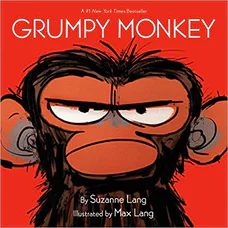Grumpy Monkey
Written by Suzanne Lang
Illustrated by Max Lang
32 pages
•
Published 2018 (Random House Books for Young Readers)

Recommended Age Range: Preschool through 2nd grade.
Publisher's Summary:
Jim the chimpanzee is in a terrible mood for no good reason. His friends can’t understand it–how can he be in a bad mood when it’s SUCH a beautiful day? They have lots of suggestions for how to make him feel better. But Jim can’t take all the advice…and has a BIT of a meltdown. Could it be that he just needs a day to feel grumpy?

Dr. Annie's Takeaways
Recommended for: This book helps kids to recognize when they’re feeling grumpy (and maybe also sad, as is common with grumpiness), and it gives children permission to feel grumpy without needing to try to fix it right away. The story validates how annoying it is when everyone tries to give you unsolicited advice for how to feel better, and it ends with a sweet moment between friends who agree that “it’s a wonderful day to feel grumpy.”
Would a child like it? Many children will really like this book. It has some funny moments, and it validates a mood that everyone feels now and then."
Evidence-Based Practices:
Emotional Literacy
Tone: Silly, validating
Story Quality: This story’s message is that it’s okay to feel grumpy, which is a refreshing contrast to the many children’s books (and social media posts) trying to teach us to be happy all the time. Grumpy Monkey (who, I must gripe, is a great ape and not a monkey) is a likable curmudgeonly chimpanzee.
Illustrations: Expressive watercolor and ink drawings with a bit of messiness to match Jim Panzee’s mood.
Representation: Jim Panzee is a male ape. He has a gorilla friend named Norman. There are many other animals who try to offer Jim advice (e.g., porcupine, snake, lion, hyena). None of them have specified genders. The story takes place in a jungle.
Psychological Practices: This story validates how annoying it is when one is feeling grumpy and everyone jumps in with unsolicited advice (e.g., “You should sing with us,” “You should roll with us,” “You should take a bath,” “You should take a nap”), and it shows how having one’s mood accepted by a loved one is often the most effective first step to feeling better. In this story, Jim wakes up in a bad mood, and all of his friends immediately want to know why he’s feeling grumpy. Jim denies being grumpy and tries to fake feeling happy, but it doesn’t work. His friends all offer advice– some of it decent but all of it unsolicited– until Jim loses his temper and storms off. Once he is alone, Jim realizes that he is feeling grumpy, and also sad. “Just as he was starting to feel really sad,” his friend Norman joins him and asks if he’s still feeling grumpy. Jim says to Norman, “Yes…but I’ll probably feel better soon enough…For now I need to be grumpy.” Norman responds, “It’s a wonderful day to be grumpy” which makes Jim feel “a little bit better.” It’s a nice reminder that grumpy moods don’t last forever and that sometimes welcoming a mood is a quicker path to feeling better than trying to push the feelings away. This strategy fits well with Acceptance and Commitment Therapy (ACT)
principles.
Concerns: Jim isn’t a perfect role model when it comes to managing his grumpy mood. He’s rude to his friends, and he loses his temper and storms off. That said, we see Jim grow over the course of the book–he realizes that he is, in fact, feeling grumpy and sad and that what he needs is a friend to be there with him until he feels better. This progression is great to discuss with a child. Some question you might want to ask: Why is Jim telling his friends that he isn’t grumpy? Why doesn’t he want to take any of his friends’ advice? How could Jim have told his friends what he needs in a more respectful way? How can you tell when you are feeling grumpy? What do you need when you are feeling grumpy and sad? Is there anyone (Mom, Dad, etc.) you wish were more like Norman?
